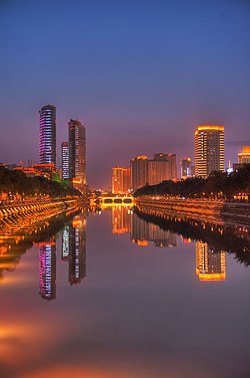| Jin River (Jin Jiang River) | |
|---|---|
 Jin River in Chengdu | |
 | |
| Location | |
| Country | China |
| Physical characteristics | |
| Source | |
| • location | Dujiangyan |
| Mouth | |
• location | Pengshan |
| Length | 97.3 km |
| Basin size | 2,090 km2 (810 sq mi) |
| Basin features | |
| River system | Yangtze River System |
| Cities | Chengdu |
| Bridges | Anshun Bridge |
The Jin River (Chinese: 锦江; pinyin: Jǐn Jiāng) is a river of Sichuan, China. It flows through the provincial capital of Chengdu.[1] It consists of three parts: the Fu River, an extension of the Fu River (Chinese: 府河) and the Nan River(Chinese: 南河).[1] The Jin River has a long and complex cultural history, dating back to 256 BC when it was formed.[2] Over the course of several dynasties, the Jin River has been given different names by the ruler in power at the time.[3] Flowing the provincial capital of Chengdu city, the river historically provided a source for irrigation, boat travel, and a means to dispose of wastewater.[3][4][5][1] As the cities’ population increased, pollution of the river became a major environmental concern leading to regulation projects beginning in 1993.[6] The current ecological state of the river is degraded as it is overloaded with dissolved nitrogen and phosphorus inputs from urban sources.[7] Alongside the riverbank of the Jin River, theme parks were built and numerous tourism programs were created.[8]
- ^ a b c 袁庭栋 (2010-04-01). 成都街巷志 (English: The Streets and Hubs Record of Chengdu). 四川教育出版社. ISBN 978-7-5408-5138-5.
- ^ "李冰父子与都江堰 (English: Li Bing and Dujiangyan)". 中国科技奖励 (5): 77–79. 2020. ISSN 1672-903X.
- ^ a b "锦江附府河南河 (English: Jin River, Fu River and Nan River)". 豆瓣 (in Chinese (China)). Retrieved 2021-03-25.
- ^ "都江堰自然地理 (English: Nature Geography of Dujiangyan)". 都江堰市人民政府 Government of City Dojiangyan.
- ^ 王, 德新; 王, 晓春 (1994). "成都府、南河航运的兴衰与复航展望 (English: Chengdu, the Corridor Shipping History of Nan River and Prospect )". 四川环境 (2): 71–74.
- ^ 唐, 烽耀; 李, 晶晶 (2012). "浅谈成都府南河滨水景观开发建设 (English: On the Development and Construction of Funan River Waterfront Landscape in Chengdu)". 四川建筑. 32 (1): 16–18.
- ^ 吴, 怡; 郭, 亚飞; 曹, 旭; 李, 天卉; 邓, 天龙 (2013). "成都府南河叶绿素a和氮、磷的分布特征与富营养化研究 (Study of the Distribution Pattern of Chlorophyll a, Nitrogen, Phosphorus and Their Relationship to Eutrophication in Funan River of Chengdu)". 中国环境监测 Journal of China Environmental Monitoring. 29 (4): 43–49. ISSN 1002-6002.
- ^ 张樵苏 (2019-02-07). "夜游锦江迎春来 古诗里的成都照进现实 (English: A Night Tour of Jin River to Welcome the Spring, Chengdu in the Story Shines into Reality )". 新华网(Xin Hua Net).